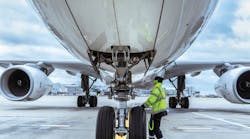The challenge of universal design in the 21st century is ability. Participating in a travel event hinges on a passenger’s ability to perform a complex series of tasks in a given period of time.
Volumes of studies have been conducted within the airline industry to provide airports and airlines insight into streamlining processes for the majority of the traveling public. Despite advances since the world's first scheduled passenger airline service, the St. Petersburg-Tampa Airboat Line in 1914, there are still areas for improvement.
By 2030, approximately one in five Americans will be older than 65. To address this upcoming demographic shift, we wanted to study ways in which to improve the spaces we create. To do so, a team of three researchers and 50 volunteers, all designers and architects from Corgan, used an age simulation suit and tested our hypothesis: that aging passengers have a dramatically different experience while navigating within an airport terminal.
Our study focused on three restricted abilities that require advancement in universally accessible airline travel: mobility, sight and hearing.
Mobility
Mobility is one of the most daunting challenges faced in designing airports. The tremendous space required by airline operations often mean that the passengers have to traverse great distances to get from curbside to holdroom. It is not uncommon to walk half a mile or more from the terminal curbside to one’s seat on the aircraft. At this point, however, the passenger’s journey is really only half over. A nearly identical process occurs in reverse upon arrival at the destination airport.
To test mobility, our study tasked volunteers to participate in a mock travel experiment. We started at the curbside and gave each participant a roller bag and had them re-create the typical travel path within an active airport terminal. With the exception of TSA Screening, due to actual screening operations at the terminal, the entire process included the typical steps a passenger would be expected to perform: curbside drop-off, airline check-in and baggage check, using airport maps and flight information displays, navigating to departure gate, use of terminal amenities all the way through exiting the secure area of the concourse and claiming luggage. The experiment even created a last-minute gate change to force our participants to adjust to an unanticipated situation.
Our results showed:
- The amount of bending and maneuvering when traversing the terminal was the biggest challenge
- Participants needed greater concentration when approaching an escalator
- Restricted neck movement made it harder to read signage
- Even in open areas, participants felt constricted due to the fast pace of others
- The distance required for walking seemed daunting
- Retrieving luggage from the baggage claim was difficult
In designing future terminals, overall walk distance by passengers must be addressed. Since the constraints at each airport are different and the factors influencing them can fluctuate greatly based on factors such as tenant airline and fleet mix, each solution is unique to the airport it serves and there are supplements that can reduce the overall travel distance such as moving walkways, inter-terminal shuttles and automated people movers. Our research shows that an aging, mobility impaired passenger requires twice as long to navigate a terminal as a younger ambulatory passenger.
Another interesting observation was an anxiety mindset created from uncertainty while navigating a new space. The passengers in our research realized that mistakes during their journey meant the possibility of doubling their effort to reach their destination. The possibility of a wrong turn created hesitancy and doubt in an already stressful situation. This hesitancy can lead to passengers missing obvious queues or wayfinding signage that would have guided them to their correct destination.
In fact, our findings like this have a profound effect on the evaluation of wayfinding signage. If the passengers most in need of directional wayfinding signage are the very passengers focusing the majority of their attention elsewhere, they are missing the signage meant to help them navigate.
Sight and Sound
Design that anticipates the adverse health conditions experienced by our increasing aging population will make airports more responsive to passenger needs. Not only in the U.S. but around the world, designers need to create spaces that address myriad of health-related maladies, all while remaining cohesive, cost-effective and resilient. Of the five senses — sight, hearing, touch, taste and smell — only two — sight and hearing — can be dealt with effectively in the built environment. As designers, sight is the sense on which we have the biggest impact. When planning a terminal we have the ability to control light levels and the passenger’s perception of the space. Most designers envision an ideal passenger that appreciates the sense of space and is aware of the subtle changes in architecture that queue direction changes and make the journey from entry door to gate, seamless. This is not the case in most airports. The amount of visual clutter such as advertising, concessions and airline signage is staggering and often in direct conflict with the existing building design.
As the traveling public ages, an increased number of passengers will suffer with common eye diseases. We must acknowledge and consider these individuals’ needs. According to the National Eye Institute, low vision, macular degeneration, cataracts, diabetic retinopathy, glaucoma and retinitis pigmentosa rates in the U.S. are rising rapidly. More passengers with moderate to severe eye diseases are a larger percentage of the flying public than ever before.
Similarly, age-related hearing loss is one of the most common conditions affecting older and elderly adults. Known officially as presbycusis, this hearing loss gradually occurs in most of us as we grow older. The National Institute on Deafness and Other Communication Disorders (NIDCD) states, approximately one in three people in the U.S. between the ages of 65 and 74 has hearing loss and nearly half of those older than 75 have difficulty hearing. Hearing loss can make it hard to understand and follow verbal instructions, public announcements and respond to warnings like smoke alarms. It can also make it difficult to enjoy conversations, leading to feelings of isolation.
To test eyesight and hearing ability, our study asked participants to utilize wayfinding signage and the public announcement system to orient themselves as they journeyed through the terminal.
Our results showed:
- Glare caused by bright sun and white/muted finishes made it challenging to read signs
- Backlit signs were easier to identify/read, especially at long distances
- Participants were surprised at how dark their surroundings seemed
- Hearing was muffled, low, and distant and comprehension required intense focus on audio source
- The PA system was the only sound easily identified but over time was ignored as background noise
Suggestions for enhancing passenger experience
There are a number of options for enhancing passenger experience for new and existing airport terminals. As more aging passengers continue to fly for work or leisure, areas of innovation and improvement can easily be addressed. Targeted fixes can then be implemented as part of larger modernization programs. Innovations that address limitations of aging passengers’ mobility, sight and hearing create an airport terminal experience that provides a better outcome for passengers, airlines and operators.
Innovations for mobility improvements with the travel experience span from drop-off to the departing plane to pick up at the final destination. Enhancing passenger experience starts at the curbside, with the creation of areas with level transitions and special loading and unloading areas for mobility-challenged passengers located close to check-in areas. Allowing elderly passengers to bypass queues during the check-in process reduces fatigue and chances for falls. The process of acquiring escorting privileges for caregivers can be made more robust and easier to obtain, relieving the airport or airline from the responsibility of providing that service.
Another area of improvement involves creating additional information regarding procedures and passenger routes and making them available online so that concerned passengers can get a sense of their journey in advance of their actual flight. The location and frequency of terminal maps including point-of-view style maps oriented to the passenger’s position in the terminal is another potential improvement. Information desks should be staffed by individuals willing to escort and assist aging passengers, should they become disoriented. The integration of smartphone technology could provide turn-by-turn style directions within terminals for passengers in need of special assistance.
Designing airport terminals for an aging population will take a concerted effort from designers, airlines and airport operators. It will take a strategic effort to create spaces that respond to the sight limitations passengers have now and will have in the near future. Reduction of visual clutter within the terminal will require stronger tenant design guidelines by airport operators. Restrictions need to be placed on airlines and concessionaires so as to not overwhelm passengers with promotional signage or display areas. Lighting levels, glare and appropriate amounts of contrast need to be analyzed during design to determine adverse effects to passengers and staff. Integration of comprehensive wayfinding signage schemes need to complement and reinforce the terminal design vocabulary to create a synergy of information rather than a competition. Use of thoughtfully placed, highly visible, back-lit signage can be used to enhance the passenger’s journey and ease anxiety.
Much like the goal to reduce visual clutter with the airport terminal, sound and volume levels need to be taken into consideration to create a more peaceful, stress-free travel experience. As more of the traveling public experience hearing loss, the design of the terminal needs to make appropriate accommodations. The first area in need of improvement is better control of announcement zones within the terminal. The mix of terminal-wide security announcements and flight-specific announcements needs to be fine-tuned to reduce overlap and to prevent “bleed-over” to other spaces that do not need the same information. Auditory announcements could be reduced and supplemented by a series of auxiliary visual display monitors that list gate change or specific flight status updates, thereby allowing passengers to see the updates rather than hear them. Targeted announcements are still needed for passengers with vision impairments, but this solution could reduce the frequency of audio announcements in the terminal. Better smartphone integration or display pop-ups over terminal wifi systems announcing airline flight updates or other important information would also reduce the amount of audible communication and “noise.”
Ultimately, we’re trying to build spaces that people enjoy and can thrive in; spaces that will stand the test of time. For us, this research has been extremely helpful in understanding the challenges the aging face in travel through airports. We’ve already begun to apply our findings to current projects and look forward to subsequent studies informing future designs.
As a Registered Architect at Corgan, Michael Steiner is involved with projects from early schematic design through construction administration as well as project close-out documentation and post-occupancy assessments. He experience with a variety of project types ranging from ground-up terminals and building additions to focused renovations within existing facilities. Mike understands that the successful completion of a project is a team effort and maintains a solutions-based approach when coordinating with design and construction teams.





